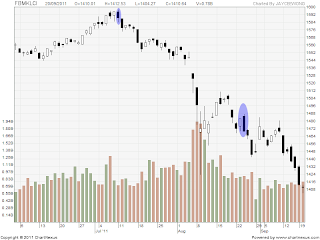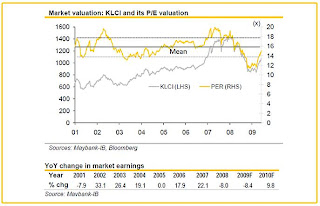S&P 500 Daily Chart as at 30-Nov-2011

Source: Stockcharts.com
DJIA Daily Chart as at 30-Nov-2011

Source: Stockcharts.com
KLCI Daily Chart as at 1-Dec-2011

Source: Tradesignum.com\chart
Looking at these fantastic charts alone, I would have thought that EU leaders have finally found a grand solution to the Euro crisis and the US is out of recession risk. Not even close! What caused the uprise then?
#1 Coordinated action by six central banks to provide cheaper access to U.S. dollar funding
http://www.cnbc.com//id/45492184
http://www.businessinsider.com/fed-ecb-boj-boe-snb-bank-of-canada-announce-coordinated-intervention-2011-11
#2 China Cuts Reserve Ratio
http://www.bloomberg.com/news/2011-12-01/asian-stocks-advance-after-central-banks-ease-dollar-funding.html
What does the Lending Cost Cut and and Reserve Ratio Cut indicate?
#1 These arrangements should indicate just how frightened governments around the world are about the European financial crisis
http://online.wsj.com/article/SB10001424052970204012004577069960192509068.html?mod=asia_home
#2 China Reserve-Ratio Cut May Signal Slowdown
http://www.bloomberg.com/news/2011-11-30/china-cuts-reserve-requirement-for-banks-as-europe-crisis-threatens-growth.html
Does anyone care about the fall of PMI in China?
China Factory Sector Shrinks First Time in Nearly 3 Years
http://www.cnbc.com/id/45501162
China Manufacturing Falls for First Time Since 2009
http://www.bloomberg.com/news/2011-12-01/china-s-manufacturing-shrinks-for-first-time-since-2009-on-europe-impact.html
Or the Unsustainable yield that Italy has to pay for its government bond?
http://www.bloomberg.com/apps/quote?ticker=GBTPGR10:IND
Or that the Leading Indicators still points to recession risk in the US?
http://www.oecd.org/department/0,3355,en_2649_34349_1_1_1_1_1,00.html
Investors craves so much for a Santa rally that they put on rose tinted glasses while reading the news, picking only the good side of a report and brushing aside the rest.
When the reality that none of the crises have been resolved slaps them in the face, investors will go into another bout of panic selling. It's bound to happen isn't it?
































